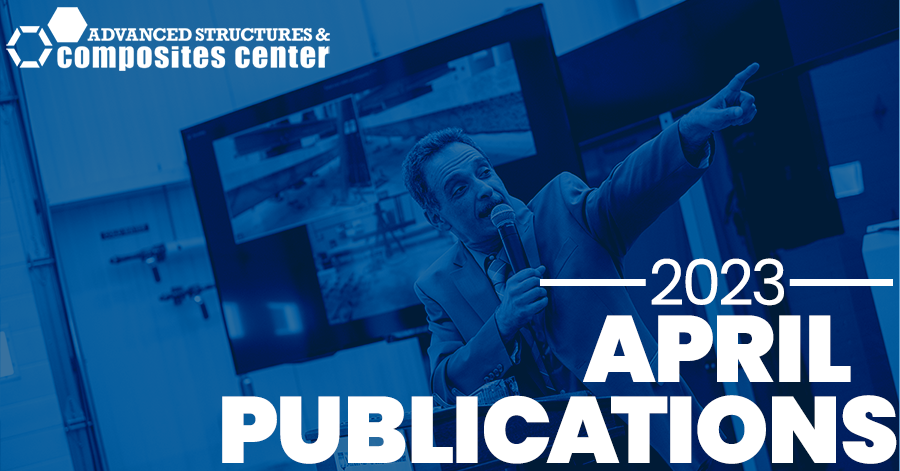
Five articles authored by ASCC researchers were published in April!
ASCC researchers published in Structures
ASCC researchers Andrew Schanck, Jon Pinkham, Dr. Keith Berube and Dr. Bill Davids recently published a paper in Structures.
The article, “Assessment of web shear stresses and shear capacity of FRP composite tub girders for highway bridges,” aims to characterize the shear strength, buckling resistance, and distribution of live load shears in fiber-reinforced polymer composite tub girder highway bridges to improve the efficiency and safety of future designs. Fiber-reinforced polymer (FRP) structures are becoming more prevalent in infrastructure applications, particularly bridges. Researchers at the Transportation Infrastructure Durability Center have developed a FRP highway bridge girder designed to replace conventional steel and concrete girders. The results of this study provide insight into composite tub girder web shear behavior and suggest areas for future research.
Article by Gallant published in Geo-Congress
An article by ASCC researcher Dr. Aaron Gallant was recently published in the journal Geo-Congress. The paper, “A p-y Q-z Method for Analyzing Helical Piles under Lateral Loading” was co-authored with researchers from Geosyntec Consultants and the University of Antioquia in Colombia.
Helical piles are often used for underground construction to hold large components in place. Conceived as a technology for offshore applications, helical piles are used in a variety of scenarios where wind, or inclined loads, are the critical design condition. In this article, researchers present a simplified methodology for analyzing helical piles under lateral loading that combines p-y curves around the shafts with Q-z curves around the plates. The methodology is validated with a 3D finite element analysis at different soil conditions and displacement levels.
TIDC collaborators explore next-generation bridge monitoring with Unmanned Aerial Systems (UAS) or drones
“Bridge deck underside evaluation with contacting and non-contacting UAS-mounted sensors” present a solution that could potentially revolutionize the way bridges are inspected. The authors propose using Unmanned Aerial Systems (UAS) or drones to inspect the undersides of bridges. UAS systems offer a supplement to conventional inspection methods that are difficult, expensive, and dangerous, such as snooper trucks or human inspection methods.
Center, collaborating on TIDC project C20.2020: “Advanced Sensing Technologies for Practical UAV-Based Condition Assessment” which was presented at the 2023 SPIE Smart Structures + Nondestructive Evaluation conference in Long Beach, California.
ASCC’s Amrit Verma published in Renewable and Sustainable Energy Reviews
An article led by ASCC researcher and Assistant Professor of Mechanical Engineering Dr. Amrit Verma was published in Renewable and Sustainable Energy Reviews, a notable wind energy journal with an Impact Factor (IF) of 16.79, titled “A review of impact loads on composite wind turbine blades: Impact threats and classification”. The researchers investigate the impact loads on composite wind turbine blades, including identifying and classifying impact threats on blades, describing their quantitative and qualitative characteristics, discussing vulnerable blade regions susceptible to impact loads and ultimately providing modeling guidelines for damage-tolerant blades. Other authors include Jiquan Yan, Weifei Hu, Zhiyu Jiang, Wei Shi, and Julie J.E. Teuwen.
Amrit Verma published in the Journal of Offshore Mechanics
An article authored by ASCC researcher and Assistant Professor of Mechanical Engineering Dr. Amrit Shankar Verma was recently published in Journal of Offshore Mechanics and Arctic Engineering. Titled “A code-to-code comparison for dynamic modeling and response analysis of offshore wind turbine blade mating process”, researchers set out to compare the codes for numerical models of offshore wind turbine blade mating processes using a crane developed by two widely-used analytical tools, Orcaflex and Sima. Other authors include Saravanan Bhaskaran, Shuai Yuan, Zhiyu Jiang, and Karl Henning Halse.
